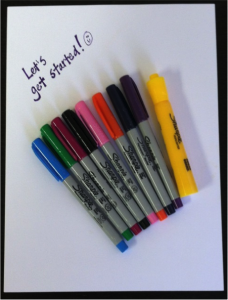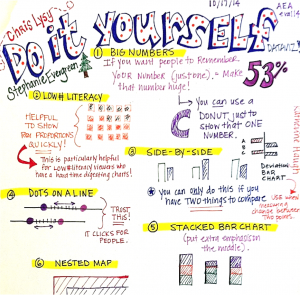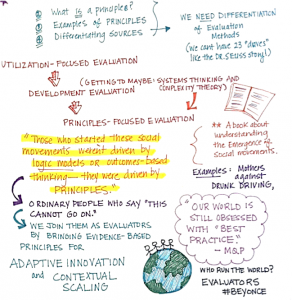Hello, I’m Katherine Haugh, an evaluator at Innovation Network—a nonprofit consulting firm based in Washington DC. What is the best way that you retain and recall information? Do text-heavy reports speak to you? Or do you prefer images, infographics and colorful fonts?
I recently attended AEA’s 2014 conference in Denver, Colorado. While I was there, I took notes during the panels, presentations and workshops that I attended and uploaded them on my Twitter handle and website. Some of you expressed interest in learning about how I take my notes. Below I’ve listed some “how to” tips for taking visual notes that can be customized to your own personal style.
Step 1: Find the right mix for you (and your audience)
There are many different techniques for taking notes. For me, a plain white sheet of paper with an equal balance of images and text allows me to quickly recall what I wrote down.
 Hot Tip: Organization is key. No matter the format, the more organized your notes are—the higher likelihood that you’ll remember what you wrote. The goal is to keep your notes short, but have enough triggers in key words, images or symbols to jog your memory when you look them over.
Hot Tip: Organization is key. No matter the format, the more organized your notes are—the higher likelihood that you’ll remember what you wrote. The goal is to keep your notes short, but have enough triggers in key words, images or symbols to jog your memory when you look them over.
Step 2: Get the right tools
The best way to learn what technique works for you is to try out different options. Test out different color combinations, spacing, and symbols. Maybe too much color is overwhelming for you or you prefer stars to arrows. I like to stick with a darker base color and add punches of bright color for important items.
Hot Tip: If you prefer hand-written notes, stay away from inky pens—they smear easily! You don’t have to be an artist to be a brilliant note taker. The most important thing is to create notes that capture what’s most important in an organized, succinct, and readable fashion.
Step 3: Make it personal
Without question, one of the most effective ways to retain information is to make it personally significant to you. For example, drawing a picture of swirl might indicate that you were confused by something covered in a presentation. This is helpful when you need to quickly scan through your notes to find the parts you want to pay the most attention to. I often incorporate dorky jokes into my notes to help me recall what I wrote.
 Hot Tip: Write your own notes in your own words. Try to stay away from copying down verbatim from a PowerPoint slide. Ideally, you want your notes to supplement a presentation—not copy it.
Hot Tip: Write your own notes in your own words. Try to stay away from copying down verbatim from a PowerPoint slide. Ideally, you want your notes to supplement a presentation—not copy it.
Questions, suggestions or feedback? Please reach out. I’d love to hear from you!
Do you have questions, concerns, kudos, or content to extend this aea365 contribution? Please add them in the comments section for this post on the aea365 webpage so that we may enrich our community of practice. Would you like to submit an aea365 Tip? Please send a note of interest to aea365@eval.org . aea365 is sponsored by the American Evaluation Association and provides a Tip-a-Day by and for evaluators.



Hi Zoraya,
Thank you for your comment! I’m very happy to hear that you’ll be giving my note-taking strategy a try. Please let me know if I can help in any way. Happy New Year!
Katherine
Katherine,
I like your strategy for note-taking. It is an excellent way to chunk information into something more meaningful. I will have to follow your recommendations the next time I go to a conference–which will hopefully be the 99U Conference in April 2015.
Best,
Zoraya Cruz-Bonilla
Data Research Assistant
Binghamton University